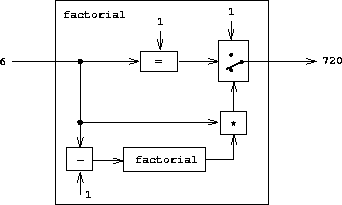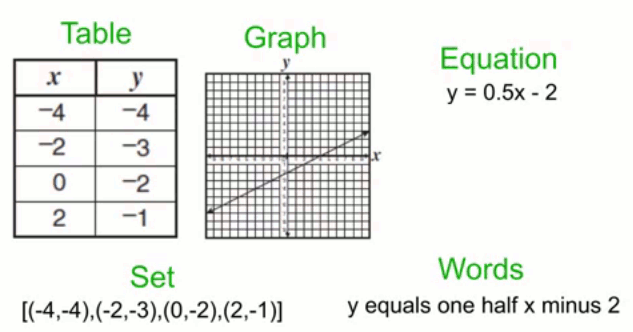Programmers love to discuss programming languages. Besides debating their own merits, we integrate them into our identities and even infer things about others who use them. Some even defend a form of Linguistic Determinism that thinking is limited to what is typable.
Since we spend so much time using languages, an interest in making them better is justified. However, the character of these debates suggests that we think of them as something more. Perhaps we have forgotten their primary role. Programming languages are implementation tools, not thinking tools. They are strict formal languages invented to instruct machines in a human-friendly way. In contrast, thoughts are best expressed through a medium which is free and flexible.
The natural language which has been effectively used for thinking about computation, for thousands of years, is mathematics. Most people don't think of math as free or flexible. Their experience of seeing scary symbols and memorizing steps in school is quite the opposite. I hope readers of this article have had a better experience with math, such as in a discrete math or linear algebra course; the kind that involves constructing clear definitions and deductions, and is written in prose with a mix of symbols (most symbols weren't even invented until the 16th century).
Math allows you to reason about logical structures, free from other constraints. This is also what programming requires: creating logical systems to solve problems. Take a look at the basic pattern for programming:
- Identify a problem
- Design algorithms and data structures to solve it
- Implement and test them
In practice, work is not so well organized as there is interplay between steps. You may write code to inform the design. Even so, the basic pattern is followed over and over.
Notice that steps 1 and 2 are the ones that take most of our time, ability, and effort. At the same time, these steps don't lend themselves to programming languages. That doesn't stop programmers from attempting to solve them in their editor, but they end up with code that is muddled, slow, or that solves the wrong problem. It's not that programming languages aren't good enough yet. It's that no formal language could be good at it. Our brains just don't think that way. When problems get hard, we draw diagrams and discuss them with collaborators.
Ideally, steps 1 and 2 are solved first, and only then will a programming language be used to solve step 3. This has an added benefit of transforming the implementation process. With a mathematical solution in hand, you can then focus on choosing the best representation and implementation, and writing better code, knowing what the end goal will be.
Why are programming languages burdensome thinking tools? One reason is that writing code is inseparably connected with implementation. Implementation concerns are necessary for instructing computers and are worth doing well, but they also distract from the problem to be solved. Think about all the considerations for writing a simple function:
- What inputs should I provide?
- What should they be named?
- What types should they be? (Even dynamically typed languages must consider types, it's just implicit.)
- Should I pass them by value or by reference?
- What file should I put the function in?
- Should the result be reused, or is it fast enough to recalculate it every time?
The list can go on. The point is that these considerations have nothing to do with what the function does. They distract from the problem the function is trying to solve.
Many languages aim to hide details such as these, which is helpful, especially for mundane tasks.
However, they cannot transcend their role as an implementation tool.
SQL is easily one of the most successful examples of this, but it is ultimately concerned with implementation concerns such as tables, rows, indices, and types.
Because of this, programmers still design complicated queries in informal terms, like what they want to "get," before writing a bunch of JOINs.
Another limitation of programming languages is that they are poor abstraction tools. Typically, when we discuss abstraction in engineering, we mean hiding implementation details. A complex operation or process is packaged into a "black box" with its contents hidden and well-defined inputs and outputs exposed. Accompanying the box is a fictional story about what it does, that is easy to understand.
Black boxes are essential for engineering large systems since the details are too overwhelming to hold in your head. They also have many well-known limitations. A black box leaks because its brief description cannot completely determine its behavior. The opaque interfaces introduce inefficiencies, like duplication and fragmented design.
Most importantly for problem-solving, black boxes are rigid. They present a fixed level of abstraction which may be too high-level or too low-level for the problem. In theory, you can always look inside the box, but in code, the abstraction level at any one time is fixed. They also offer only one perspective of abstraction. A high-level web server may provide a terrific interface for serving JSON, but be useless if one wants an interface for serving incomplete data streams, such as output from a program.
In contrast, the word abstraction in math is nothing like hiding information. Here, abstraction means extracting the essential features or characteristics of something, in relation to a particular context. Unlike black boxes, no information is hidden. They don't leak in the same way. You are encouraged to adjust to the right level of abstraction and quickly jump between perspectives:
- Is this problem best represented as a table? Or, a function?
- Can I look at the whole system as a function?
- Can I treat this collection of things as a single unit?
- Should I look at the whole system or a single part?
- What assumptions should I make? Should I make them stronger or weaker?
Just look at the many ways of looking at a function:
Major branches of math represent commonly useful abstractions:
- Geometry abstracts fundamental shapes from objects in the world (or transformation invariants, depending on how cosmic you want to get).
- Topology abstracts surface features from their shapes.
- Group theory abstracts binary operations to properties about how they are composed and inverted.
However, these fields aren't the limit. You can pick the properties that are important to the problem and ignore everything else. The example project at the end shows how this is done.
Programming languages are great for building black boxes; they provide functions, classes, and modules, all of which help wrap up code into nice interfaces. However, when trying to solve problems and design solutions, what you actually want is the math kind of abstraction. If you try to think at the keyboard, the black boxes available to you will warp your view.
Just as programming languages are limited in their ability to abstract, they also are limited in how they represent data. The very act of implementing an algorithm or data structure is picking just one of the many possible ways to represent it. Typically, this is not a decision you want to make until you understand what is needed.
For example, graphs (sets of vertices and edges) appear in many programming problems such as internet networks, pathfinding, and social networks. Despite their simple definition, choosing how to represent them is hard and depends on their use case:
-
The one which most closely matches the definition:
vertices: vector<NodeData> edges: vector<pair<Int, Int>> -
If you only care about connectivity, the vertices can be defined implicitly:
edges: vector<pair<Int, Int>> -
If you want to traverse a node's neighbors quickly, then you probably want a node structure:
Node { id: Int, neighbors: vector<Node*> } -
You could use a connectivity matrix. Where each row stores the neighbors of a particular node:
connectivity: vector<vector<int>> -
Pathfinding algorithms often work on graphs implicitly from a board of cells:
walls: vector<vector<bool>>
Math allows you to reason about the graph itself, solve the problem, and then choose an appropriate representation. If you think in a programming language, you cannot delay this decision as your first line of code commits to a particular representation.
Note that a plurality of representation means creating a completely reusable graph library is impractical.
Either it works on a few, or forces all graphs into an inappropriate representation.
That doesn't mean libraries aren't useful.
Similar representations are needed again and again (like std::vector),
but you cannot write a library which solves a graph problem once and for all.
Some modern programming languages attempt to provide more mathematical abstraction tools.
For example, Haskell has Ring and Group typeclasses.
However, the representation issues show that these features must be less useful than their theoretical inspirations.
It is smart to write an algorithm which relies only on the associative property and document it is as such.
This is thinking in the language of math.
But, in practice, it can only reasonably work on a small family of similar types.
A simple generic with a few types in mind is appropriate.
As a corollary, programming languages should focus primarily on being useful implementation tools, rather than thinking tools. C got this right in a big way. Modern language features such as C#'s async and await offer great improvements in this direction.
So what does thinking in math look like? Recently, I worked on an API at work for pricing cryptocurrency for merchants. It takes into account recent price changes and recommends that merchants charge a higher price during volatile times.
Although we did some homework on the theory, we wanted to empirically test it to see how it performed during various market conditions. To do so, I designed a bot to simulate a merchant doing business with our API, to see how it performs.
BTC/USD (1 day)
Definition: The exchange rate r(t) is the market rate of fiat/crypto.
Definition: The merchant rate r'(t) is the modified exchange rate which the merchant is advised to charge customers.
Definition: When a customer buys an item, we call that event a purchase.
A purchase consists of the price in fiat and a time. p = (f, t).
Theorem: The amount of crypto for a purchase is found by applying the modified exchange rate
t(p) = p(1) / r'(p(2)).
Proof: p(1) / r'(p(2)) = fiat / (fiat/crypto) = fiat * crypto/fiat = crypto
Definition: When the merchant sells their crypto holdings, we call that event a sale.
A sale consists of an amount in crypto and a timestamp. s = (c, t).
Theorem: The amount of fiat the merchant obtained from a sale is found by applying the exchange rate to the sale g(s) = s(1) * r(s(2)).
Proof: s(1) * r(s(2)) = crypto * (fiat/crypto) = fiat
Definition: The balance of a set of purchases and sales is the difference between all purchase crypto amounts and all sale crypto amounts.
b(P, S) = sum from i to N of t(p_i) - sum from j to M of s_j(1)
Note that b(P, S) >= 0 must always hold.
Definition: The earnings of a set of purchases and sales is the difference between sale fiat amounts and purchase fiat amounts.
e(P, S) = sum from j to M of g(s_j(1)) - sum from i to N of p_i(1) >= 0.
Definition: We say that the merchant rate is favorable iff the earnings are non-negative for most sets of typical purchases and sales.
r'(t) is favorable iff e(P, S) >= 0 .
In a favorable case, the merchant didn't lose any fiat by accepting crypto.
most and typical will not be rigorously defined.
As part of typical, we can assume that merchants will sell their crypto in a timely manner.
So assume s_i(2) - s_j(2) < W for i,j in {1.. M} for some bound W.
Purchase amounts should be randomly distributed within a reasonable range that commerce is done. Perhaps $10-100.
The goal of the bot is to verify that r'(t) is favorable.
Note that this definition is only one measure of quality. Perhaps protecting against the worst case is more important than being favorable. In that case, we would be concerned about the ability to construct a set of purchases with very negative earnings.
Repeat many times:
-
Randomly choose a time range
[t0, t1]. -
Generate a set of purchases at random times within
[t0, t1]. The price should fall within a range[p0, p1] of typical prices. -
Generate a set of sales at evenly spaced times (perhaps with slight random noise) within
[t0, t1]. Each sale should be for the full balance at that time. -
Calculate the earnings for these sets.
-
Record the earnings.
After:
- Report how many earnings were negative and non-negative. Show a percentage for each.
- Identify the minimum and maximum earnings and report them.
As you read this example, I think your tendency may be to think that its statements are obvious. Certainly, none of these steps are hard. However, it was surprising to me how many of my assumptions were corrected and how difficult it was to choose an objective definition of a favorable outcome. This process helped me become aware of assumptions I would not have even considered if I had started by simply writing code. Perhaps the greatest benefit was that after writing it, I was able to quickly review it with a co-worker and make corrections which were easy on paper, but would have been difficult to change in code.
I hope that thinking in the language of math will bring similar benefits to your projects! Note that this example is only one style of utilizing mathematical thinking. I recommend reading others by Leslie Lamport, Udi Manber, and Alex Stepanov.



